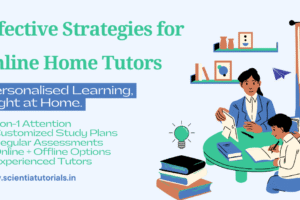Cultivating Minds: Teaching Tips for Home Tutors on Developing Critical Thinking Skills in Students Through Home Tutoring
Introduction
In today’s fast-paced, information-rich world, the ability to think critically is more important than ever. Critical thinking skills enable students to analyze, evaluate, and synthesize information effectively, leading to better decision-making and problem-solving capabilities. As home tutors, you play a vital role in fostering these skills in your students, empowering them to navigate academic challenges and real-life situations with confidence and insight.
This article will explore practical teaching tips for home tutors to develop critical thinking skills in students through effective home tutoring methods. By incorporating strategies that stimulate inquiry, reflection, and analysis, tutors can create a learning environment where critical thinking flourishes.
1. Understanding Critical Thinking
What is Critical Thinking?
Critical thinking is the process of actively analyzing, synthesizing, and evaluating information gathered from observation, experience, or communication. It involves the ability to think independently, question assumptions, and draw reasoned conclusions based on evidence.
Key Components of Critical Thinking:
- Analysis: Breaking down complex information into manageable parts for better understanding.
- Evaluation: Assessing the credibility and relevance of information sources.
- Inference: Drawing logical conclusions based on available evidence.
- Explanation: Clearly articulating the reasoning behind one’s thought processes.
- Reflection: Thinking about one’s own thinking to improve understanding and reasoning skills.
Understanding these components is essential for tutors as they develop lesson plans and activities that encourage critical thinking.
2. Creating a Stimulating Learning Environment
The Role of Environment in Fostering Critical Thinking
A stimulating learning environment is crucial for encouraging students to engage in critical thinking. When students feel safe, supported, and inspired, they are more likely to explore ideas, ask questions, and challenge their own assumptions.
Tips for Creating a Positive Learning Environment:
- Encourage Open Communication: Foster a culture of open dialogue where students feel comfortable sharing their thoughts and ideas without fear of judgment.
- Promote Curiosity: Use thought-provoking questions and prompts that stimulate curiosity and inspire students to think deeply about various subjects.
- Be Approachable: Build rapport with your students so they feel at ease discussing their thoughts and asking questions.
- Use Real-World Contexts: Relate lessons to real-world situations, making the material relevant and encouraging students to think critically about how it applies to their lives.
Creating a supportive environment allows students to thrive and develop critical thinking skills effectively.
3. Encouraging Questioning
The Power of Questions in Developing Critical Thinking
Asking questions is a fundamental component of critical thinking. It allows students to explore concepts in depth, clarify their understanding, and challenge assumptions. Home tutors can play a pivotal role in teaching students how to formulate and pursue meaningful questions.
Strategies to Encourage Questioning:
- Model Inquiry: Demonstrate how to ask insightful questions during discussions. Encourage students to ask “how” and “why” rather than just “what.”
- Use Socratic Questioning: Engage students in Socratic questioning, which involves a dialogue where students are prompted to think critically about their responses and explore their reasoning.
- Create a Question-Friendly Culture: Encourage students to ask questions without hesitation. Remind them that there are no “bad” questions, and all inquiries contribute to learning.
- Challenge Assumptions: Encourage students to question established norms or beliefs. Ask them to consider alternative viewpoints and the reasoning behind those perspectives.
By promoting a culture of questioning, tutors can enhance students’ critical thinking abilities and encourage deeper exploration of subjects.
4. Implementing Active Learning Strategies
Hands-On Learning for Deeper Understanding
Active learning involves engaging students in the learning process through interactive activities and discussions. This approach encourages critical thinking by allowing students to explore concepts in a hands-on manner.
Effective Active Learning Strategies:
- Group Discussions: Facilitate group discussions on relevant topics, allowing students to share their viewpoints, debate ideas, and learn from one another.
- Case Studies: Present students with real-life scenarios or case studies. Ask them to analyze the situation, identify key issues, and propose solutions based on their critical thinking skills.
- Role-Playing: Engage students in role-playing activities where they must assume different perspectives on an issue. This helps them understand multiple viewpoints and think critically about their responses.
- Projects and Presentations: Encourage students to work on projects that require research and analysis. Presenting their findings to peers fosters confidence and critical evaluation of their work.
Active learning strategies not only make the learning process enjoyable but also promote critical thinking through engagement and interaction.
5. Teaching Problem-Solving Skills
Critical Thinking Through Problem-Solving
Problem-solving is an integral part of critical thinking. Home tutors can help students develop problem-solving skills by presenting challenges that require them to think critically and creatively.
Steps for Effective Problem-Solving:
- Define the Problem: Teach students how to clearly articulate the problem they are facing. Encourage them to identify the key factors involved and what makes the situation challenging.
- Gather Information: Guide students in gathering relevant information and evidence. Discuss how to assess the credibility and reliability of sources.
- Generate Solutions: Encourage brainstorming sessions where students can propose multiple solutions to the problem. Remind them to consider both conventional and unconventional approaches.
- Evaluate Options: Teach students to evaluate the pros and cons of each solution. Encourage them to consider the potential consequences of their decisions.
- Implement and Reflect: After choosing a solution, have students implement it and reflect on the outcome. Discuss what worked, what didn’t, and what could be improved in future problem-solving situations.
By emphasizing problem-solving skills, tutors can equip students with essential tools to navigate academic and real-life challenges effectively.
6. Incorporating Critical Thinking Activities
Engaging Activities to Foster Critical Thinking
Incorporating specific activities designed to promote critical thinking can be a highly effective teaching strategy. These activities can stimulate student engagement while enhancing their analytical skills.
Examples of Critical Thinking Activities:
- Debates: Organize debates on controversial topics. Students must research their stance, understand opposing viewpoints, and articulate their arguments effectively.
- Brain Teasers and Puzzles: Use brain teasers, logic puzzles, and riddles to challenge students’ thinking processes and encourage them to think outside the box.
- Reflective Journals: Have students maintain reflective journals where they regularly write about their thoughts, ideas, and experiences. This encourages self-reflection and deeper thinking.
- Mind Mapping: Introduce mind mapping as a visual tool to help students organize their thoughts and ideas. It encourages them to see connections and relationships between different concepts.
- Think-Pair-Share: Use the think-pair-share method, where students first think about a question individually, then discuss their thoughts with a partner, and finally share their insights with the larger group.
These activities create opportunities for students to practice and refine their critical thinking skills in enjoyable and engaging ways.
7. Utilizing Technology to Enhance Critical Thinking
Leveraging Technology for Innovative Learning
In today’s digital age, technology can play a significant role in enhancing critical thinking skills. Home tutors can integrate technology into their teaching strategies to create interactive and dynamic learning experiences.
Ways to Use Technology in Critical Thinking Development:
- Online Discussion Forums: Encourage students to participate in online discussion boards or forums where they can engage in thoughtful conversations on various topics.
- Interactive Learning Platforms: Utilize interactive learning platforms that promote collaborative problem-solving and critical analysis.
- Educational Apps: Recommend educational apps that focus on critical thinking games and challenges, allowing students to practice their skills in an entertaining format.
- Digital Research Projects: Have students conduct research on specific topics using digital resources. Teach them how to evaluate the credibility of online information and synthesize their findings.
By harnessing the power of technology, tutors can create rich learning experiences that enhance students’ critical thinking skills and prepare them for a technology-driven world.
8. Encouraging Self-Reflection and Metacognition
Building Awareness of Thought Processes
Self-reflection and metacognition (thinking about one’s own thinking) are essential for developing critical thinking skills. Encouraging students to reflect on their thought processes helps them become more aware of how they arrive at conclusions and decisions.
Strategies to Promote Self-Reflection:
- Reflection Questions: Ask students to reflect on their learning experiences by posing questions such as, “What strategies worked well for you?” or “What challenges did you encounter?”
- Self-Assessment: Encourage students to assess their performance and identify areas for improvement. Provide rubrics or criteria for self-evaluation.
- Goal Setting: Help students set personal learning goals based on their reflections. This encourages them to take ownership of their learning journey and think critically about their progress.
By promoting self-reflection and metacognition, tutors can foster deeper understanding and critical thinking in their students.
Conclusion
Developing critical thinking skills in students through home tutoring is a rewarding endeavor that equips them with essential tools for academic and life success. By creating a supportive learning environment, encouraging questioning, implementing active learning strategies, and fostering problem-solving skills, home tutors can guide students toward becoming independent, reflective thinkers.
In an increasingly complex world, the ability to think critically is crucial. As home tutors, you have the unique opportunity to cultivate these skills in your students, empowering them to analyze information, make informed decisions, and face challenges with confidence. By incorporating these teaching tips into your tutoring practice, you can help students not only excel academically but also become thoughtful, engaged members of society.



